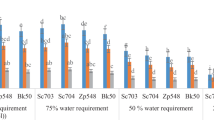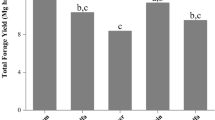Abstract
The cost and scarcity of water is placing increasing pressure on Australian dairy farmers to utilise water for forage production as efficiently as possible. This study aimed to identify perennial forage species with greater water-use efficiency (WUE) than the current dominant species, perennial ryegrass (Lolium perenne L.). Fifteen perennial forage species were investigated under optimum irrigation and two deficit irrigation treatments, over three years at Camden, NSW, on a brown Dermsol in a warm temperate climate. Under optimal irrigation, there was a nearly twofold difference in mean WUEt (total yield/evapotranspiration) between forages, with kikuyu (Pennisetum clandestinum Hochst. ex. chiov.) having the highest (27.3 kg ha−1 mm−1) and birdsfoot trefoil (Lotus corniculatus L.) the lowest (14.8 kg ha−1 mm−1). Kikuyu was also the most water use efficient forage under the extreme deficit irrigation treatment, although its mean WUEt declined by 15% to 23.2 kg ha−1 mm−1, while white clover (Trifolium repens L.) in the same treatment had the largest decline of 44% and the lowest WUEt of only 8.8 kg ha−1 mm−1. In order to maximise WUE for any forage, it is necessary to maximise yield, as there is a strong positive relationship between yield and WUEt.



Similar content being viewed by others
References
ABS (2006) Water account Australia 2004–05 4610.0. ABS, Canberra
Allen RG, Pereira LS, Raes D, Smith M (1998) Crop evapotranspiration: guidelines for computing crop water requirements. Irrigation and drainage paper 56. FAO, Rome
Aparicio-Tejo PM, Sanchez-Diaz MF, Pena JI (1980) Nitrogen-fixation, stomatal response and transpiration in Medicago sativa, Trifolium repens and Trifolium subterraneum under water-stress and recovery. Physiol Plant 48:1–4
Bauder JW, Bauer A, Ramirez JM, Cassel DK (1978) Alfalfa water-use and production on dryland and irrigated sandy loam. Agron J 70:95–99
Begg JE, Turner NC (1976) Crop water deficits. Adv Agron 28:161–217
Blaikie SJ, Martin FM (1987) Limits to the productivity of irrigated pastures in south-east Australia. In: Wheeler J et al (eds) Temperate pastures: their production, use and management. Australian Wool Corporation/CSIRO, Melbourne, pp 119–122
Boot RGA (1989) The significance of size and morphology of root systems for nutrient acquisition and competition. In: Lambers H et al (eds) Causes and consequences of variation in growth rate and productivity of higher plants. SPB Academic Publishing, Netherlands, pp 299–312
Carter PR, Sheaffer CC (1983) Alfalfa response to soil-water deficits.1. growth, forage quality, yield, water-use, and water-use efficiency. Crop Sci 23:669–675
Cooper JP (1970) Potential production and energy conversion in temperate and tropical grasses. Herb Abstr 40:1–15
Doorenbos J, Pruitt WO (1977) Crop water requirements Irrigation and Drainage Paper 24. FAO, Rome
Douglass W, Poulton D (2000) Living with limited water—towards efficient water use on irrigated dairy pastures. ICID J 49:29–40
Durand JL, Onillon B, Schnyder H, Rademacher I (1995) Drought effects on cellular and spatial parameters of leaf growth in tall fescue. J Exp Bot 46:1147–1155
Edraki M, Humphreys E, O’Connell N (2003) Soil water dynamics and components of water balance for irrigated lucerne in southern NSW. CSIRO, Griffith, NSW
Fereres E, Soriano MA (2007) Deficit irrigation for reducing agricultural water use. J Exp Bot 58:147–159
French RJ, Schultz JE (1984) Water-use efficiency of wheat in a mediterranean-type environment.1. the relation between yield, water-use and climate. Aust J Agric Res 35:743–764
Fulkerson WJ, Donaghy DJ (2001) Plant-soluble carbohydrate reserves and senescence—key criteria for developing an effective grazing management system for ryegrass-based pastures: a review. Aust J Exp Agric 41:261–275
Fulkerson WJ, Fennell JFM, Slack K (2000) Production and forage quality of prairie grass (Bromus willdenowii) in comparison to perennial ryegrass (Lolium perenne) and tall fescue (Festuca arundinacea) in subtropical dairy pastures. Aust J Exp Agric 40:1059–1068
Fulkerson WJ, Neal JS, Clark CF, Horadagoda A, Nandra KS, Barchia I (2007) Nutritive value of forage species grown in the warm temperate climate of Australia for dairy cows: grasses and legumes. Livest Sci 107:253–264
Gales K (1979) Effects of water-supply on partitioning of dry-matter between roots and shoots in Lolium-perenne. J Appl Ecol 16:863–877
Geeves GW, Craze B, Hamilton GJ (2007) Soil physical properties. In: Charman PEV, Murphy BW (eds) Soils: their properties and management, 3rd edn. Oxford University Press, South Melbourne, pp 168–191
Goulburn-Murray Water (2008) Price history of trading zone [Online]. http://www.watermove.com.au/results/pricesummary.asp (verified 20 March)
Greenwood KL, Dellow KE, Mundy GN, Kelly KB, Austin SM (2006) Improved soil and irrigation management for forage production 2. Forage yield and nutritive characteristics. Aust J Exp Agric 46:319–326
Hanks RJ, Sullivan TE, Hunsaker VE (1977) Corn and Alfalfa Production as Influenced by Irrigation and Salinity. Soil Sci Soc Am J 41:606–610
Hart A (1987) Physiology. In: Baker M, Williams W (eds) White clover. CAB International, Wallingford
Howell TA, Meron M (2007) Irrigation scheduling. In: Lamm FR et al (eds) Microirrigation for crop production: design, operation, and management. Elsevier, Amsterdam
Humphreys LR, Partridge IJ (1995) A guide to better pastures for the tropics and subtropics, 5th edn. NSW Agriculture, Newcastle, NSW
Isbell RF (2002) Australian soil classification. CSIRO, Canberra
Jensen KB, Asay KH, Waldron BL (2001) Dry matter production of orchardgrass and perennial ryegrass at five irrigation levels. Crop Sci 41:479–487
Kelly KB, Stockdale CR, Mason WK (2005) The productivity of irrigated legumes in northern Victoria. 1. Effect of irrigation interval. Aust J Exp Agric 45:1567–1576
Kemp PD, Mathew C, Lucas RJ (2004) Pasture species and cultivars. In: White J, Hodgson J (eds) New Zealand pasture and crop science. Oxford University Press, Melbourne
Klepper B, Taylor HM, Huck MG, Fiscus EL (1973) Water relations and growth of cotton in drying soil. Agron J 65:307–310
Kramer PJ, Boyer JS (1995) Water relations of plant and soils. Academic Press Inc, United States of America, San Diego
Lawson AR, Kelly KB (2007) Responses to the renovation of an irrigated perennial pasture in northern Victoria. 2. Botanical composition, and plant and tiller densities. Aust J Exp Agric 47:159–169
Lawson AR, Greenwood KL, Kelly KB (2009) Irrigation water productivity of winter-growing annuals is higher than perennial forages in northern Victoria. Crop Pasture Sci 60:407–419
Linehan C, Armstrong DP, Knee JE, Doyle PT, Bowman K, Johnson F, Gyles OA (2001) Changes in water use efficiency on irrigated dairy farms in northern Victoria. Department of Natural Resources and Environment, Agriculture Victoria, Tatura & Kyabram, Victoria
Lodge GM, Orchard BA (2000) Effects of grazing management on Sirosa phalaris herbage mass and persistence in a predominantly summer rainfall environment. Aust J Exp Agric 40:155–169
Lolicato SJ (2000) Soil water dynamics and growth of perennial pasture species for dryland salinity control. Aust J Exp Agric 40:37–45
Lowe KF, Bowdler TM, Casey ND, Moss RJ (1999) Performance of temperate perennial pastures in the Australian subtropics—1. Yield, persistence and pasture quality. Aust J Exp Agric 39:663–676
Malik RS, Dhankar JS, Turner NC (1979) Influence of soil-water deficits on root-growth of cotton seedlings. Plant Soil 53:109–115
McDonald W, Nikandrow A, Bishop AL, Lattimore M, Gardner P, Williams R, Hyson L (2003) Lucerne for pasture and fodder. Agfact P2.2.25, 3rd edn. NSW Agriculture, Orange, NSW
McKenzie FR, Jacobs JL, Kearney G (2006a) Effects of spring grazing on dryland perennial ryegrass/white clover dairy pastures. 2. Botanical composition, tiller, and plant densities. Aust J Agric Res 57:555–563
McKenzie FR, Jacobs JL, Ward G (2006b) Irrigated dairy pasture yield and water use efficiency responses to summer applied nitrogen. Proc N Z Grassl Assoc 68:161–164
Moore G, Sanford P, Wiley T (2006) Perennial pasture plants for Western Australian Department of Agriculture and Food, Perth, Western Australia
Neal M, Neal JS, Fulkerson WF (2007) Choosing the best forage species for a dairy farm: the whole-farm approach. J Dairy Sci 90:3044–3059
Neal JS, Fulkerson WJ, Lawrie R, Barchia IM (2009) Difference in yield and persistence among perennial forages used by the dairy industry under optimum and deficit irrigation. Crop Pasture Sci 60:1071–1087
Payne RW, Harding SA, Murray DA, Soutar DM, Baird DB, Glaser AI, Channing IC, Welham SJ, Gilmour AR, Thompson R, Webster R (2008) Genstat release 11 reference manual, Part 2 directives. VSN International, Hemel Hempstead
Purcell LC, Currey A (2003) Gaining acceptance of water use efficiency framework, terms and definitions AQC1. Land Water Australia, Canberra
Rawnsley RP, Donaghy DJ, Fulkerson WJ, Lane PA (2002) Changes in the physiology and feed quality of cocksfoot (Dactylis glomerata L.) during regrowth. Grass Forage Sci 57:203–211
Reeves M, Fulkerson WJ, Kellaway RC (1996) Forage quality of kikuyu (Pennisetum clandestinum): The effect of time of defoliation and nitrogen fertiliser application and in comparison with perennial ryegrass (Lolium perenne). Aust J Agric Res 47:1349–1359
Ridley AM, White RE, Simpson RJ, Callinan L (1997) Water use and drainage under phalaris, cocksfoot, and annual ryegrass pastures. Aust J Agric Res 48:1011–1023
Salisbury FB, Ross CW (1992) Plant physiology. Wadsworth Publishing Company, Belmont
Sammis TW (1981) Yield of alfalfa and cotton as influenced by irrigation. Agron J 73:323–329
Sheaffer CC, Tanner CB, Kirkham MB (1988) Alfalfa water relations and irrigation. In: Alfalfa and alfalfa improvement. American Society of Agronomy, Crop Science Society of America, Soil Science Society of America, Madison, Wisconsin USA, pp 373–409
Smeal D, Gregory EJ, Arnold RN (1992) Interseasonal variability in the water use-production function of Alfalfa. J Prod Agric 5:576–580
Smeal D, O’Neill MK, Arnold RN (2005) Forage production of cool season pasture grasses as related to irrigation. Agric Water Manage 76:224–236
Steduto P, Hsiao TC, Fereres E (2007) On the conservative behavior of biomass water productivity. Irrig Sci 25:189–207
Stout WL, Schnabel RR (1997) Water use efficiency of perennial ryegrass as affected by soil drainage and nitrogen fertilization on two floodplain soils. J Soil Water Conserv 52:207–211
Tanner CB, Sinclair TR (1983) Efficient water use in crop production research or re-search? In: Taylor HM et al (eds) Limitation to efficient water use in crop production. American Society of Agronomy, Madison, pp 1–28
Watson P (2006) Dairying for tomorrow: survey of NRM practices on dairy farms. Dairy Australia, Melbourne
Watson RW, McDonald WJ, Bourke CA (2000) Phalaris pastures Agfact P2.5.1, 2nd edn. NSW Agriculture, Orange, NSW
Acknowledgments
This study was financially supported by Dairy Australia, DIDCO, Industry and Investment NSW, The University of Sydney, Wrightson seeds and PGG seeds. We are grateful to many staff involved in the project including Ajantha Horadagoda, Kuldip Nandra, Lindsay Campbell, Peter Beale, Peter Orchard, Euie Havilah, Paul Looby, Nawash Haddad, Wim Van Kouterik, Didi Lam, Shannon Bennetts and Kristine Riley. Idris Barchia, Peter Thomson and Navneet Dhand provided valuable advice and assistance with statistical analysis. We thank Kerry Greenwood, Alister Lawson, Kevin Kelly, Ron Hacker, Mark Norton and Sean Murphy for their comments on the manuscript.
Author information
Authors and Affiliations
Corresponding author
Additional information
Communicated by S. Raine.
Rights and permissions
About this article
Cite this article
Neal, J.S., Fulkerson, W.J. & Sutton, B.G. Differences in water-use efficiency among perennial forages used by the dairy industry under optimum and deficit irrigation. Irrig Sci 29, 213–232 (2011). https://doi.org/10.1007/s00271-010-0229-1
Received:
Accepted:
Published:
Issue Date:
DOI: https://doi.org/10.1007/s00271-010-0229-1




